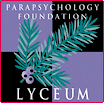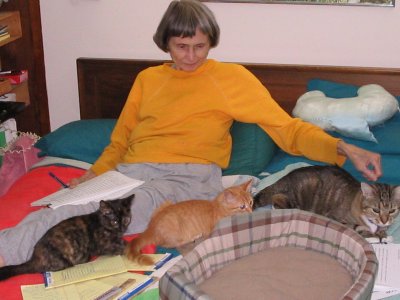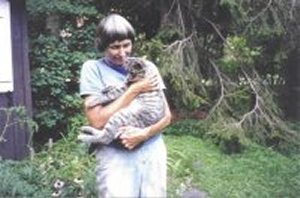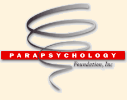 |
 |

Remembering Rhea Dianne Arcangel email: DianneArcangel@yahoo.com “I heard you’re a hospice chaplain,” began with Rhea White, the first time we talked. “What we want, we may not get, and I doubt it will be this way for me, but …” Rhea then described how she wanted to live before she died, and she continued her descriptions during our first few years of conversing. I, as well as her other colleagues, grew to know Rhea as fiercely independent and rather reclusive, especially after moving to New Bern. She complained if someone asked to visit and when she had to leave her house for any reason. Her protests grew louder with the advent of e-mail service. After Rhea stopped using the Internet, we talked over the telephone almost every Saturday, and on some weekdays she called several times. One reason I loved talking with her is that she was living exactly as she had described, some twenty years prior. Rhea painted a verbal image of her life and the home that Jean (her best friend for fifty-five years) and husband had found for her. Rhea repeatedly commented, “I’ve finally found my bliss,” “Now this is living,” “I’ve never been this happy,” “I don’t have to do anything I don’t want to do. I sit here … just being. It’s great!” Then she thoroughly detailed everything else she enjoyed, especially her cats. The most amazing thing to me was that Rhea began morphing into somewhat of a social butterfly. At first, I was surprised when she expressed great joy over her occasional Thursday nights out with Jean and her friends. Then, when she was no longer physically able to leave her home, she conveyed pleasure in being doted on by Jean, three caregivers (one lived-in overnight), neighbors, friends, hospice, and community. While the football team voluntarily groomed her yard, she called to give me a blow-by-blow account, “Oops! I’d never cut that branch that closely but it’s okay — will take longer to grow out!” she said, laughing. “I love to laugh,” Rhea said often. She equally enjoyed people. “Everybody tells me I can’t stop talking, and they’re right, I can’t.” Her personality no longer mirrored the woman I had known through the years. The news of Rhea’s death left me puzzled — people usually die in character. But then I asked Jean to refresh my memory about their first meeting. Jean wrote in her email: Rhea and I met in the fall of 1951. She had transferred to Penn State as she wanted a college where women played golf, and transfer students were assigned to me. Rhea left us an enormous body of work, as well as an example of living full circle. Although we will miss her, we can find comfort in knowing that she made her hopes and dreams come true. She lived her bliss. And then, in the end, Rhea died in character. Rhea White: An Appreciation William Braud Institute of Transpersonal Psychology I am pleased to have been asked to write a brief piece about Rhea White. I greatly value Rhea and her work, and I always have considered myself one of her biggest fans. I deeply miss her presence with us. I often told my colleagues and students that I considered Rhea to have more knowledge about parapsychology than anyone on the planet. I made that statement based on her vast bibliographic and database work and her extensive summaries of published books, chapters, and articles relevant to the field. Rhea herself made many original and significant contributions to our field. Among the most important of these, I would include reports of her own early psi research projects, in the 1950s and 1960s, involving teachers and pupils; her 1964 theoretical paper on old versus new methods of participant preparation and target responding, which inspired much successful free-response experimentation by other investigators; and her early recognition of the important roles played by researchers and by study participants other than the ostensible “subjects” in psi experiments (White, 1976a, 1976b). In these and other areas, Rhea always was steps ahead of the rest of us, providing advance notice of topics and approaches that later would prove to be important foci of fruitful research. However, to me, and to Rhea herself, her greatest contributions were not these but, rather, her later extensive work with what she called exceptional human experiences (EHEs). In a way, Rhea’s work within parapsychology was a long-lasting side trip — a rewarding and productive diversion, during which her truest interests and most heart-felt work were incubating. This work burst forth in the early 1990s with her extensive writings, presentations, and personal and professional support of EHEs and of those who experienced and studied them. Although Rhea was honored in 1992 by an Outstanding Lifetime Research Award by the Parapsychological Association for being parapsychology’s bibliographer, Rhea always maintained (and I fully agree) that this award was given for the wrong reason. Rather, Rhea should have been (and will be) recognized for her emphasis of a more experiential approach to the subject matter of psi research, for her broadening of the topics and approaches that parapsychology might fruitfully emphasize, and for her investigations and conceptualizations of EHEs and of the EHE process, through which an individual’s dedicated work with anomalous and exceptional experiences can uncover human potentials not formerly recognized and contribute to one’s psychospiritual development and transformation (White, 1997). Rhea also will be remembered for urging that we include greater feminist considerations in psi research (White, 1994), her suggestions that we greatly expand the range of research approaches to our subject matter (White, 1992, 1998b) and include intuition and heart-knowledge in our work (White, 1998c), her advocacy of greater attention to spontaneous psychic and other exceptional experiences and their meanings for the individual experiencer (almost all of her latest work), and, of course, her extensive editorial work for books and journals and her enlarging the ambit of these publications to include a greater number of contributions in areas of EHEs and transpersonal psychology. On a more personal note, I fondly recall a phone call from Rhea, in the late 1980s, asking my opinion about her planned extension of the subject matter of psi research to include areas that she later began calling EHEs (little did I realize that this was soon to become a new and important field of study), her support of my own work and writings, her gracious support of our Institute’s students’ work and of many others through contacts via personal correspondence and via the EHE Network that she and her colleagues developed (see http://www.ehe.org ), and many delightful exchanges regarding her move from Dix Hills, NY to New Bern, NC, her new home and environment, and her adventures with her friends and with the creatures she loved and enjoyed — plants, birds, jumping spiders, Daddy Longlegs, tree frogs, chameleons, and her beloved cats. In a 1982 presentation, later published in 1998(a), as well as in many of her later publications, Rhea argued that in order for parapsychology to have a successful future, it would have to progressively enlarge its topics, methods, conceptualizations, and scope, and we, as investigators, would have to involve ourselves more in our work and enlarge ourselves — that is, both the field and its workers should engage in what she called projects of transcendence. The way to go about this was well exemplified in Rhea’s own life and work. At the time of her death, Rhea had stopped most of her other projects in order to work diligently on a book about how to write an EHE autobiography and was working on her own EHE autobiography. I hope someone will be able to see those works through to completion, because these could help those in the fields of parapsychology and EHE studies realize the future that Rhea foresaw for us. Although she herself did not use such a term, I think of Rhea’s ways of knowing, doing, and being as illustrations of how we might effectively move from a more limited parapsychology (a parapsychology of knowledge) to a more expansive parapsychosophia (a parapsychology of wisdom, a term originally suggested by Tony Lawrence). Thank you, Rhea, for showing us how we might accomplish such a transition. White, R. A. (1964). A comparison of old and new methods of response to targets in ESP experiments. Journal of the American Society for Psychical Research, 58, 21–56. White, R. A. (1976a). The influence of persons other than the experimenter on the subjects’ scores in psi experiments. Journal of the American Society for Psychical Research, 70, 133–166. White, R. A. (1976b). The limits of experimenter influence on psi test results: Can any be set? Journal of the American Society for Psychical Research, 70, 333–370. White, R. A. (1992). Review of approaches to the study of spontaneous psi experiences. Journal of Scientific Exploration, 6(2), 93–126. White, R. A. (1994). The need for double vision in parapsychology: The feminist standpoint. In L. Coly & R.A. White (Eds.), Women and parapsychology (pp. 241–252). New York: Parapsychology Foundation. White, R. A. (1997). Dissociation, narrative, and exceptional human experiences. In S. Krippner & S. Powers (Eds.), Broken images, broken selves (pp. 88–121). New York: Brunner/Mazel. White, R. A. (1998a). An alternative future for parapsychology: An editorial. Journal of the American Society for Psychical Research, 92(2), 109–115. White, R. A. (1998b). Becoming more human as we work: The reflexive role of exceptional human experience. In W. Braud & R. Anderson, Transpersonal research methods for the social sciences: Honoring human experience (pp. 128–145). Thousand Oaks, CA: Sage. White, R. A. (1998c). Intuition, heart knowledge, and parapsychology. Journal of the American Society for Psychical Research, 92(2), 158–171. Rhea A. White: An Exceptional Human Experience Suzanne V. Brown Rhea was a most remarkable and precious woman. She was an Exceptional Human Experience (EHE) in my life. Her laughter and wit, her teachings, honesty, kindness, and reverence for nature in all its forms are what comes to me as I write these words. She had so much to give and gave it freely. I first telephoned Rhea in 1988 when I needed a PSILINE database search on the subject of synchronicity. It was a serendipitous call. We kept in touch via email and phone calls — something that would become an almost daily routine for us until her passing. She invited me into the realms of parapsychology, postmodernism, consciousness studies, transpersonal psychology, and exceptional human experience. I was thrilled to find someone like her — a mentor who was vastly knowledgeable, patient, and generous. I cried and hugged Rhea when I first met her on a visit in 1995 after she had moved from New York to New Bern, NC. (I live in Charlotte, NC.) We excitedly talked about the development of the Exceptional Human Experience Network (EHEN), which she had founded. As her VP, Director of Research and Development, I was fully on board. It was a blessing to know that my experiences were “going somewhere” and not trivial or something to forget. The mission of EHEN was/is to let others know the same thing … that there is a purpose for our anomalous or nonordinary experiences. That in essence, we transcend to the “More” that we are if we pay attention to/potentiate them. One day in the mid-1990s, Rhea and I were on the phone discussing EHEs. We were very animated and brainstorming together. At the same time, we both blurted out “EHE process!” We quickly started to name and describe the five stages of this transcendental process. Rhea said that she was so excited that she could not sit down. I was in my office and hurriedly took notes as we both reveled in our mutual “Aha.” We talked about that again in her last days and the feeling was still there for both of us. In 2000, Rhea had a severe bout of pneumonia that weakened her. She still continued on with the EHE Journal until 2002 (actually it was finally published in 2004 and includes both years in the last issue). She said in her editorial that she wanted to retire to write, and send portions of her various writings to the website, http://www.ehe.org. Her EHE autobiography was already well over 2,300 pages! She really loved to write and revise it as she delved deeper into the meaning and tapestry of her life. She also asked me if I would be interested in taking over the Editor’s job for the Journal of the American Society for Psychical Research (JASPR). Of course! I was very happy to continue working with Rhea, as she would remain on as the Editor-in-Chief. She taught me a lot and we vigorously worked on that Journal together until her last days, although her health was failing in the last year. Rhea is in my heart. I will remember Rhea for so many things — her love of her kitties, John Lennon’s song “Imagine,” her numerous stories of the history of the field and its people, her spunk, sharp mind, and spirit who lives on with us. Blessings to you my dear friend as you continue your journey, and thank you for blessing me. Recollections of Rhea Maria Cassano Memories of Rhea Lisette Coly http://www.parapsychology.org Certainly Rhea White’s myriad contributions to parapsychology are well known and readily apparent as illustrated by the PF Lyceum blog dedicated to her memory. Professionally both my mother, Eileen Coly, President of Parapsychology Foundation, and I have the utmost respect for her dedicated work and lasting contributions to the field. It is however her personal impact on my life that I wish to share. Rhea in her early years experienced the force of Eileen Garrett’s personality — warts and all — and hence appreciated the size of the shoes we attempted to fill in adminstering the work of the PF. Rhea, over the years, witnessed the growth of not only the organization but my own growing maturity. She was instrumental in the formation of PF’s International Conference held in Dublin, Ireland in 1991 from which I fondly hold memories of an Irish pub where we raised a pint in celebration of a successful meeting. A long time grantee of PF we were proud to support her very valuable work and we are very greatful that Rhea in obvious ill health managed to pen a Foreword and Afterword to the upcoming Helix Press release of Garrett’s book, Awareness which Rhea considerered one long EHE autobiography. I will never forget that while I was dismayed and alarmed at my turning fifty years old Rhea reassured me in conversation — and, of course, articles that she provided since she seemed always to be able to put her hand on just the right article for any occasion or scholarly paper — that my “Flaming 50’s” would be the most exciting and productive time of my life … and to relax and all would be revealed! In hindsight I realize that she was certainly correct. She often acted as a sounding board for my hopes and aspirations for PF as well as for my concerns for the future of our complex field. She would remind me often that while geneologically I drew from my grandmother and mother in running the PF I should never lose sight of the understanding that I had my own contributions to make in my own fashion. She was always in my corner and supportive of future directives I might consider … and I am overwhelmed that in death Rhea has reached out once more with a final vote of confidence in entrusting her magnificent library with Psi Line and the EHE Network into Parapsychology Foundation’s care. Her legacy will stand as well as my lifelong appreciation for her work, support and personal friendship. Rhea A. White — Architect of EHE Margaret Harrell In August 1994, Rhea and I were in contact through snail mail between Belgium and the US. I had proposed some articles on the anomalous computer activity in my apartment that began after the death of a person living there. But suddenly Rhea asked me to forget the other suggestions — and write an EHE Autobiography. There was a synchronicity. The letter came in exactly during the Maha Samadhi, that is, death transition, of Dhyanyogi Madhusudandasji. He “dropped the body” in meditation consciously in August 1994, and I’d received an initiation (“shaktipat,” or energy transfer) from him in 1992. Among his followers there was great attention given to what was happening to his energy in the Maha Samadhi. His death was on the anniversary of the birth of Lord Krishna. (His own birth had been preceded by a dream announcement, to his mother, from Lord Krishna). On that level, there was always that about my relationship with Rhea, though on the surface we were touching on more everyday things — such as papers I wrote for her, through questions that got us aligned and in which she prodded, nudged and used her needle-sharp ability to probe deeper. It was then that I first began approaching my writing through describing the EHEs, or consciousness, in essays. A couple of texts in my books were an attempt to respond to her in papers, but they kept expanding, including the introductory material to my first book, published in 1996, in progress thirty years. That was directly in response to her, with some of her editing. But one of the things I will never forget happened in 2001. She asked me to go to a light body seminar, with the idea of writing on it for her. Something memorable resulted. And we both responded, she as much as I. In a meditation, the man who had been my teacher (in life) and first inspired me to experience EHEs consciously, by being aware of his presence after death (something I’d never experienced before), initiated me into a very high form of consciousness, of the Ground of Being, in an experience of satori. In it, I experienced the workings of unity consciousness, in which everything had a “place,” and in the case of Earth, everyone had his/her own “piece of Earth.” Rhea was very struck by this dynamics of our own “piece of Earth.” It triggered associations from earlier experiences and texts for her. Also, in the seminar, to “round out” the experience of meeting Rhea, Dhyanyogi-ji brought a message. I must add that these things do not happen to me all the time. Dhyanyogi-ji, now appearing for the second time in relationship to her, brought a message that was appropriately tuned to what would happen after 9/11, though 9/11 was some months away. But a Vishnu level of consciousness was preparing protections, and on this Hindu level he took me to a meeting on the question of whether people who were only accidentally concerned in a larger transformation should be protected from being caught up negatively. According to ancient tradition, what the Guru does is hold or remove “karma,” and so it made sense that on this collective level, the topic of “karma” in mass events was on the agenda. Other experiences we enjoyed together were that she sent me her EHE Autobiography chapters. She made it a little job and I put them into a red plastic bag behind my computer and for months I would comment, with a lot of back and forth. In her EHE Autobiography, one saw the child, who had an extraordinary gift for sensing nature and could expand a brushing experience of the tiniest, oddest animal or insect or nature spot into a gripping revelation. Rhea told me that in writing, she sensed an open space; the words just “fell through.” When I mentioned “sound being,” she said that she had such a sensibility to sound, she thought she was a sound being. When I asked a psychic we had both found credible if/how my books would ever get published she answered, “I think a woman is going to help you.” Thank you, Rhea. Remembering Rhea Linda Henkel I first met Rhea in late 1983, when I was 18 years old and a freshman in college, looking to learn about parapsychology. To say that she had a profound impact on my life would be putting it lightly. I still remember the first day we met at her house to see if I might help her on some of her bibliography projects. I had never seen so many books outside of a library in my life — wall to wall parapsychology books and journals every place you looked, and her bedroom/office with piles up to the ceiling of the projects she was working on. It was like stepping into this enchanted kingdom of knowledge! Over the next twelve years, I worked with Rhea compiling bibliographies, editing JASPR, and publishing PSI Center materials. During that time, I had a son, finished my undergraduate studies, and earned a Ph.D. in cognitive psychology. It was as if I was growing up right there under her watch. I learned so much from Rhea — from some important work skills (my years helping to edit JASPR and Psi Center publications come in mighty handy as a college professor), to the very mundane (e.g., muenster cheese is a great cheese for grilled cheese sandwiches; Pepperidge Farm Milano cookies taste especially good when refrigerated), to the much more spiritual (e.g., that there is much more than meets the eye to this world; there is something undeniably beautiful and profound in the many ways that we tune into that eternal life force). Rhea helped me come to understand that we all walk different paths in our life’s journey and that the answer to the mysteries of the universe was not at the end of the road: The journey itself was the meaning, and it was ever evolving and encompasses more than life and more than death. I was there in the late 1980s and early 1990s when Rhea went through a lengthy period of illness in which it felt like I was watching her wither and then practically be reborn before my eyes. Although she had a deep respect for the scientific method, she came to realize that it was all too easy to miss the meaning and mission of science and truth seeking by literally missing the meaning of the very experiences we study. I cannot express how fascinating it was to watch Rhea after this epiphany as she started taking graduate level classes in sociology so she could better understand how to study the meaning of experiences, rather than studying how to prove or disprove their validity. I feel like in the time I have known Rhea, we have watched each other go through several lifetimes ourselves! And even when you reach this level where you think, “Oh, I get it now. I’m tuned in, I see the Truth, I’m enlightened …,” there is still something more, still more growing to do. As if it wasn’t enough for Rhea to develop the Exceptional Human Experiences Network after this revelatory insight of hers in which she stopped questioning reality and focused on experiencing meaning, she went on to take it to another level. The exhilaration I felt when she sent me her initial musings on the clarity and understanding she was gaining as she began writing her EHE autobiography is still palpable. I can still hear her chuckling when I burst out laughing when she told me she was up past page 1000 of hers! She had a great laugh, a beautiful smile, and a true love of life. She is a real inspiration — and I deliberately used the present tense in the preceding statement because I fully expect that I will still be learning from Rhea for many years to come. So much of who I am (both as a scientist and as a spiritual being blundering through this world trying to make sense of it) was shaped by my interactions with Rhea. She was always learning, always growing, and I aim to follow her lead. She lived a life with great meaning, and really, what more could one ask for than that? On Rhea White as a Mentor and a Friend Nancy L. Zingrone Email: zingrone@parapsychology.org It’s difficult to know what to say. Something deep and profound is what Rhea deserves, but also something light and joyful. She was an original, that’s for sure, someone who followed her own muse with an energy and a purposefulness that most of us don’t have. She was passionate for the work, for life, for drinking in her surroundings, engaging with her surroundings. When she was an experimentalist she was a talented one. Her 1964 review of “old and new” methodologies in parapsychology was an important catalyst for the sea change that restarted free response experimentation. Her 1984 PA Presidential Address, not loved by some, not understood by some, was for others a moving force underscoring the essential nature of our heritage, of the personal, meaningful, sometimes spiritual, sometimes transcendent experiences that underlie our need to understand what we call the paranormal, the supernormal.  So if one of her many gifts was intellectual, cutting to the quick of things, building a network to expand the definitions, sift through the meaning; another of her gifts was the ability to be a great and supportive friend, even if you were “new,” even if you were starting out, even if the only topic of mutual interest was something other than intellectual. The same passion she poured into her bibliographic work, she poured into teasing me into introducing myself to John Beloff when I was too young and awestruck to do it without a good swift verbal kick from her. The same passion she poured into her best work, she poured into the running commentary she regaled us with when she shared her cats, her garden, and her favorite Southern buffet restaurant in New Bern with Alvarado, my mother and I. (And what a set up she had there in New Bern: great neighbors, great friends, an army of cats, a master suite that was 10% bed and 90% books and computers, with a huge picture window looking out on two bird feeders that fed instead a host of incredibly athletic squirrels ...) So if one of her many gifts was intellectual, cutting to the quick of things, building a network to expand the definitions, sift through the meaning; another of her gifts was the ability to be a great and supportive friend, even if you were “new,” even if you were starting out, even if the only topic of mutual interest was something other than intellectual. The same passion she poured into her bibliographic work, she poured into teasing me into introducing myself to John Beloff when I was too young and awestruck to do it without a good swift verbal kick from her. The same passion she poured into her best work, she poured into the running commentary she regaled us with when she shared her cats, her garden, and her favorite Southern buffet restaurant in New Bern with Alvarado, my mother and I. (And what a set up she had there in New Bern: great neighbors, great friends, an army of cats, a master suite that was 10% bed and 90% books and computers, with a huge picture window looking out on two bird feeders that fed instead a host of incredibly athletic squirrels ...)
The legacy she has left is going to require an archaeological temperament. There are books and journals, thousands of pages of text and correspondence, projects done but not published, in progress but not finished, formulated in the barest outline. As it shifts to the PF and to her various other inheritors, whether they are “officially” named in her will, or they are self-nominated for the job, there will be an enormous amount of effort poured into carrying on her work. That’s the memorial Rhea deserves and the one I have no doubt will be built. |
 |

|
 www. parapsychology. org |
||